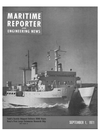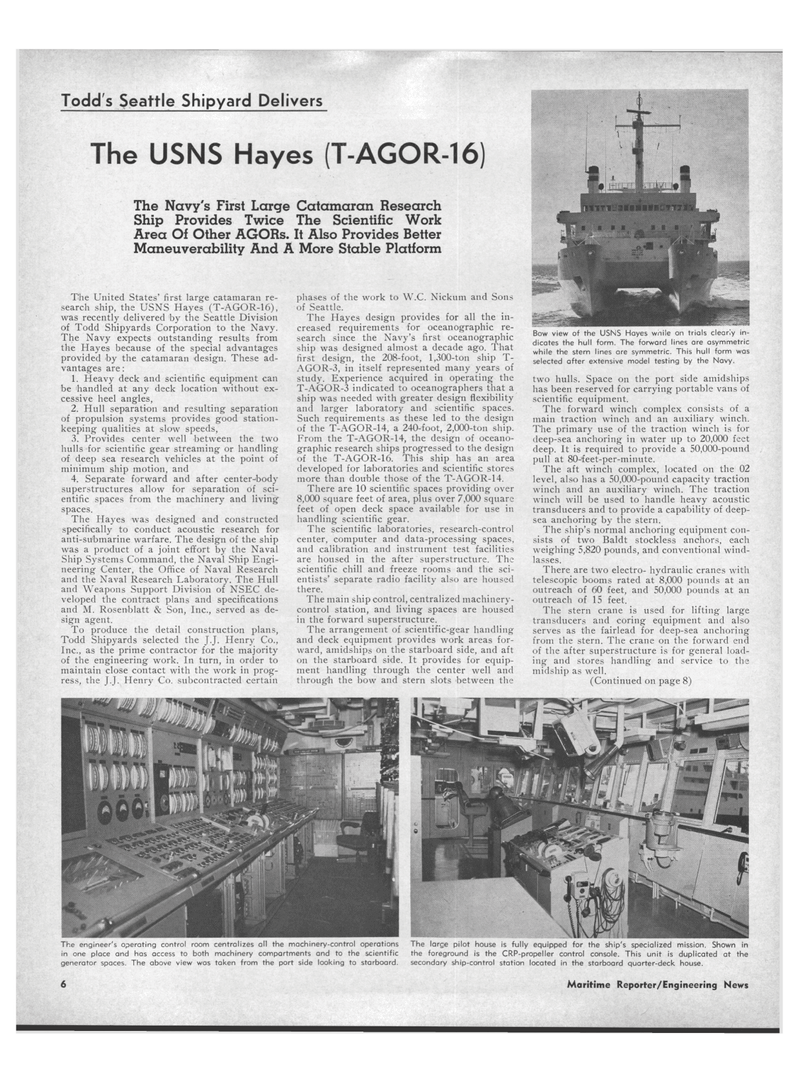
Page 4: of Maritime Reporter Magazine (September 1971)
Read this page in Pdf, Flash or Html5 edition of September 1971 Maritime Reporter Magazine
Todd's Seattle Shipyard Delivers
The USNS Hayes (T-AGOR-16)
The Navy's First Large Catamaran Research
Ship Provides Twice The Scientific Work
Area Of Other AGORs. It Also Provides Better
Maneuverability And A More Stable Platform
The United States' first large catamaran re- search ship, the USNS Hayes (T-AGOR-16), was recently delivered by the Seattle Division of Todd Shipyards Corporation to the Navy.
The Navy expects outstanding results from the Hayes because of the special advantages provided by the catamaran design. These ad- vantages are: 1. Heavy deck and scientific equipment can be handled at any deck location without ex- cessive heel angles, 2. Hull separation and resulting separation of propulsion systems provides good station- keeping qualities at slow speeds, 3. Provides center well between the two hulls for scientific gear streaming or handling of deep sea research vehicles at the point of minimum ship motion, and 4. Separate forward and after center^body superstructures allow for separation of sci- entific spaces from the machinery and living spaces.
The Hayes was designed and constructed specifically to conduct acoustic research for anti-su'bmarine warfare. The design of the ship was a product of a joint effort by the Naval
Ship Systems Command, the Naval S'hip Engi- neering Center, the Office of Naval Research and the Naval Research Laboratory. The Hull and Weapons Support Division of NSEC de- veloped the contract plans and specifications and M. Rosenblatt & Son, Inc., served as de- sign agent.
To produce the detail construction plans,
Todd Shipyards selected the J.J. Henry Co.,
Inc., as the prime contractor for the majority of the engineering work. In turn, in order to maintain close contact with the work in prog- ress, the J.J. Henry Co. subcontracted certain phases of the work to W.C. Nickum and Sons of Seattle.
The Hayes design provides for all the in- creased requirements for oceanographic re- search since the Navy's first oceanographic ship was designed almost a decade ago. That first design, the 208-foot, 1,300-ton ship T-
AGOR-3, in itself represented many years of study. Experience acquired in operating the
T-AGOR-3 indicated to oceanographers that a ship was needed with greater design flexibility and larger laboratory and scientific spaces.
Such requirements as these led to the design of the T-AGOR-14, a 240-foot, 2,000-ton ship.
From the T-AGOR-14, the design of oceano- graphic research ships progressed to the design of the T-AGOR-16. This ship has an area developed for laboratories and scientific stores more than double those of the T-AGOR-14.
There are 10 scientific spaces providing over 8,000 square feet of area, plus over 7,000 square feet of open deck space available for use in handling scientific gear.
The scientific laboratories, research-control center, computer and data-processing spaces, and calibration and instrument test facilities are housed in the after superstructure. The scientific chill and freeze rooms and the sci- entists' separate radio facility also are housed there.
The main ship control, centralized machinery- control station, and living spaces are housed in the forward superstructure.
The arrangement of scientific-gear handling and deck equipment provides work areas for- ward, amidships on the starboard side, and aft on the starboard side. It provides for equip- ment handling through the center well and through the bow and stern slots between the
Bow view of the USNS Hayes wnile on trials clearly in- dicates the hull form. The forward lines are asymmetric while the stern lines are symmetric. This hull form was selected after extensive model testing by the Navy. two hulls. Space on the port side amidships has been reserved for carrying portable vans of scientific equipment.
The forward winch complex consists of a main traction winch and an auxiliary winch.
The primary use of the traction winch is for deep-sea anchoring in water up to 20,000 feet deep. It is required to provide a 50,000-pound pull at 80-feet-per-minute.
The aft winch complex, located on the 02 level, also has a 50,000-pound capacity traction winch and an auxiliary winch. The traction winch will be used to handle heavy acoustic transducers and to provide a capability of deep- sea anchoring by the stern.
The ship's normal anchoring equipment con- sists of two Baldt stockless anchors, each weighing 5,820 pounds, and conventional wind- lasses.
There are two electro- hydraulic cranes with telescopic booms rated at 8,000 pounds at an outreach of 60 feet, and 50,000 pounds at an outreach of 15 feet.
The stern crane is used for lifting large transducers and coring equipment and also serves as the fairlead for deep-sea anchoring from the stern. The crane on the forward end of the after superstructure is for general load- ing and stores handling and service to the midship as well. (Continued on page 8)
The engineer's operating control room centralizes all the machinery-control operations The larce pilot house is fully equipped for the ship's specialized mission. Shown in in one place and has access to both machinery compartments and to the scientific the foreground is the CRP-propeller control console. This unit is duplicated at the generator spaces. The above view was taken from the port side looking to starboard. secondary ship-control station located in the starboard quarter-deck house. 6 Maritime Reporter/Engineering News

 3
3

 5
5
